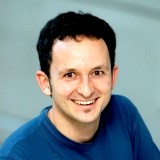�¶�������

��Eduardo
Morenoͨ����һ��ѡ����Ϊ����ǿ�����ļ�¼����ͨ�����һ�֣���鹦�����Ĵ����ԣ������к�ǿ����ԵĿ��о��ѣ���ŷ���о�ίԱ����������ϯSusan Gasserд����
����һ���ɹ���ְҵ���ģ�һ���ձ�������ǵIJ��ԣ�����ʹ����о���Ȥ���ѧ����Ϊ���ȵ��Ҵ���ϣ�����뷨�������������ʱ��Զ�����㹻�ˡ���37����������������ѧ��Eduardo
Moreno ����Ϊһ�������ѧ����30�������������ʱ���ǵ�Ȼ�����ڽ���һ���IJ���

�������������Morena��ν�ġ�������ʵʩһ������û��һ��������������������˿��õ���Ŀ��������һ�����������Ŀ��о��������нӵ�����ŷ���о�ίԱ��һ����ŷԪ�Ľ���ʱ���ⳡ�IJ�ʤ���ˣ����Һܸ��˽�ʶһЩŷ��������Ŀ�ѧ�ң���Moreno˵��
�ȹ�����������
����һ����ʦ��ͥ�Moreno�ں������������ͻ�ѧ�Լ���ʱ���γ�����ѧ����ζ�������ٽַ�������һ���ܴ���£�������������������������Ǹ���ѧרҵ�ı��������ҷ������Լ��ļ��飬���μ��������������δ�ѧ����ķ�������ѧ�д��ᡣ���Һ����ԣ��ҷ���ԭ���������ǰ����ɹ��������ģ�����˵��
Moreno������Gin��s Morata��������Severo
Ochoa��������ѧ���ĵ�ʵ���ң�����������ʿѧλ�����ڣ�����������һ����Ϊϸ������������������һ��ϸ��������������ϸ���;����γ������һ���֣���Moreno���ݵ�����Moreno������ͬ�±�����һ�۲����Ѿ���ʮ���ȥ�ˣ���������������һ�����̺ܺ�������Щ�˲���������������
Morata ����MorenoΪ��ò�ʿѧλ�Ѽ�һЩ��ʵ�����ݣ�Ȼ���ټ������ð�յ���Ŀ��Moreno�������
Moreno�ĵ�һ�ݹ�������ʵ���Ұ���һ����ʿ��Ѱ���ձ似������ȷ���������ٷ����Ͷ�λ���»�����ʹ�����Եڶ����߳�����һƪ�����ڡ���ѧ����־���ģ���������ʼ������ʿѧλ���á���������ר���о�����һ���·��ֵĻ���β������¼�����ڲ�Ӭ�β��γɹ��̵����ã�����ַ���һƪ���ģ���һ�����ڡ���Ȼ����־�ϣ����ǵ�һ���ߡ��������Ϊ��Ӯ���˲�ʿѧλ������������Ҫ����������������δ�ѧ���ر����������ﻯѧ���������ѧ�����innogenetics�����ѧ�ҽ���
����ʱ��
��Moreno�ռ����й�β��������ϣ�����5��IJ�ʿ���Ľ�������һ��룬����������о����ȣ�������Ĵ���������һ���ݳޣ�����˵�����ڲ�ʿѧλ��ʤȯ���գ���˵��������ʼ�о�ϸ���������Ƿ�������ִ��Ŵ�ѧ�������о��ͽ��͡���
����һ�꣬���������Morata��ʵ��������ʿ������Konrad
Baslerһ������ʿ����������ѧ����Moreno�ܹ�����ǰϸ���ľ����������������ý����ij�����ϸ��������ϵ����������������ϸ���ܹ�����������ʶ�����ϸ��������ʹ���ǡ�������������ϸ��Ⱥ�е�һ����̬ϵͳ������˵��������ʿ֤���˸ü��裬�ַ�����һƪ��Ϊ��һ���ߵ����ģ�����Ȼ����־�ϣ�����ʹ����Ӯ����Severo
Ochoa��������ѧ���ĵ�һ������Լ�Charles Rodolphe Brupbacher�����������о�Ա����
Moreno��������һ������ϸ�����������֢�����ͬԴ�������������û���ֻҪ���������ͻ������ϸ��ת��Ϊ�����������ߣ�����ʹ��Χϸ����Ϊ�����ǻ��Ķ��Ҽ���������ϸ������
ð�յ��뷨
Moreno������2005��������������������Ұ�֢�о�����(CNIO)��5�����������������CNIO�ʽ�Caja Madrid��Mutua
Madrile?a �������ܹ����о��������൱��������飬����˵��
Ϊ�����Լ���Ϊһ�������Ŀ�ѧ�ң���������취��ȡ��������������ѧ�������Ե���Դ���������������뱻���أ����й�������̫û�о���������Գе���˺�����Ŀ��Ȼ������һ�α������һ����һ�Ρ�
��������˵������Ϊ���˵����飬�������Ҫ�����Ŀ�����ҡ� ���ϵĵݳ����룬ϣ����ѧ����ʶ�����ǵĴ�����˵��
![]() ���Ϸ���!
���Ϸ���!
�¶�������
E��ʱ��������AT&T��������ҽѧ��Ϣϵͳ
���������ѵ�����
ȼ��Ҭ���͵ķɻ�
"Eduardo Moreno made it through the first selection because of his
strong past record and made it through the last round thanks to the innovative, yet
highly relevant, nature of his grant," writes ERC jury panel chair Susan Gasser.
A common and sensible strategy for a successful career is to align your
research interests with ideas the scientific community thinks are hot and promising. But
sometimes a long shot really pays off. When Spanish developmental biologist Eduardo
Moreno, 37, set to provide an explanation for an observation that had puzzled scientists
for 30 years, he certainly was taking a gamble.
Earlier this year, after what Morena calls "3 years of carrying on a project that
almost nobody within the Spanish funding agencies believed in," the gamble paid off
when he received an award of �1 million from the European Research Council in a highly
competitive research funding call. "I was very happy to get some validation by the
best scientists of Europe," Moreno says.
Work first, play later
Born to a family of lawyers, Moreno explored an early taste for science
playing with microscopes and chemistry kits with friends. "It was a big thing in
the neighborhood," he recalls. Later, he attended a development biology conference
at the Universidad Aut��noma de Madrid while he was a biochemistry undergrad and
discovered his passion. "I was fascinated that there were rules to construct the
body of animals," he says.
Moreno joined the lab of Gin��s Morata at the Severo Ochoa Molecular Biology Centre in
Madrid. Early in his Ph.D., he encountered a phenomenon called cell competition whereby
"one of the cell types start[s] not allowing the other cell type to form part of
the body," as Moreno puts it. Thirty years had passed since Morata and colleagues
had reported the observation, but "it was very obscure what was going on there.
Some people didn't believe [in] it." Morata advised Moreno to gather some solid
data for a Ph.D. before taking on such a risky project, Moreno recalls.
Play time
When Moreno finished gathering data on the caudal gene, he still had a year
and a half before the official completion of his 5-year Ph.D. "The pace that
research goes today, it's almost a luxury to have a couple of years to play
around," he says. His Ph.D. secure, he says he set out to see if cell competition
"was a topic we could study with modern genetics methods and explain it."
During that year, and subsequent years spent as a postdoc in Morata's lab (and later
with Konrad Basler at the University of Zurich, Switzerland), Moreno was able to link
the previously isolated phenomenon of cell competition to the well-established process
of programmed cell death. He hypothesized that normal cells were able to recognize
suboptimal cells during development and force them to die, "a lot like an
ecological system in a population of cells," he says. He proved the hypothesis in
Switzerland and published another first-author paper (this one in Nature). The result
won him a prize from the Severo Ochoa Molecular Biology Centre and the Young
Investigator Award from the Charles Rodolphe Brupbacher Foundation.
Moreno also found a homologue of a human cancer gene involved in cell competition. He
demonstrated that, when activated, this gene could transform regular cells into
"supercompetitors: cells that �� are able to make the surrounding cells believe that
they are bad cells and �� [need] to die."
A risky idea
Moreno was pulled back to Spain in 2005 by a 5-year junior-leader position
at the Spanish National Cancer Research Centre (CNIO) in Madrid. Start-up funding from
CNIO, Caja Madrid, and Mutua Madrile?a "allowed me to do research and have a
relatively big group of seven persons," he says.
To establish himself as an independent scientist, he had to attract grant money, and the
Spanish Ministry for Science was the obvious source. But his grant application to
the Spanish ministry was rejected; the judges claimed the he was too inexperienced to
take on such an ambitious project. Then it was rejected again, and again, and again.
"For me, it became personal. I really wanted this project, and I �� kept sending it
in the hope [the ministry] would realize their mistake," he says.
The vote of confidence--and investment--Moreno sought eventually came from a less likely
source: the European Research Council (ERC). In one of the most competitive funding
calls of European history, Moreno won an ERC Starting Independent Researcher Grant,
worth �1 million, to fund his research during the next 5 years. "We had 720
applicants to our panel for 18 grants; in other words, only 2-3% got funded,"
writes Susan Gasser, chair of the ERC jury panel that made the award, in an e-mail to
Science Careers. "Eduardo Moreno made it through the first selection because of his
strong past record and made it through the last round thanks to the innovative, yet
highly relevant, nature of his grant, and his compelling presentation of his
ideas."





